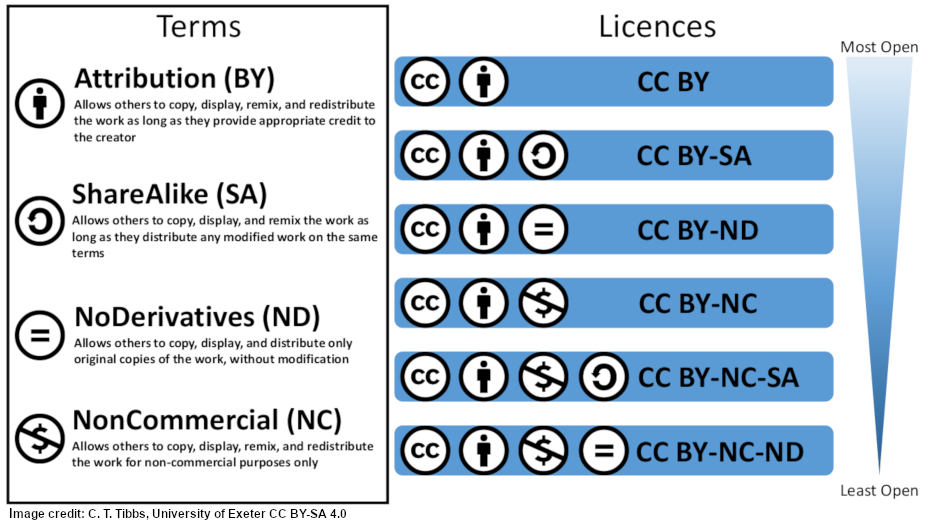Data discovery and re-use
Data discovery and re-use
Data discovery and re-use
Data discovery and re-use
Licensing your data
If you are making your data publicly available, you should license your data. A licence determines how others can use, modify, and distribute your data.
Creative Commons (CC) licences provide an easy way to manage the copyright terms that attach automatically to all creative material under copyright law (visit the Copyright Toolkit for further details on copyright). CC licences allow material to be shared and re-used under terms that are flexible and legally sound. Creative Commons offers a core suite of six copyright licences. Since there is no single CC licence, it is important to identify which of the six licences you are applying to your data.
All of the CC licences require that users provide attribution (BY) to the creator when the material is used and shared. Attribution is the only condition to re-use of material licensed as CC BY. This most liberal licence is preferred by most research funders and is a requirement of some.
The other five licences combine BY with one or more of three additional licence elements: NonCommercial (NC), which prohibits commercial use of the material; NoDerivatives (ND), which prohibits the sharing of adaptations of the material; and ShareAlike (SA), which requires adaptations of the material be released under the same licence.
An alternative to the six CC licences discussed above is the CC0 – No Rights Reserved option. Unlike the CC licences which allow you to retain your copyright, CC0 enables you to waive your copyright protection and place the data in the public domain allowing others to freely re-use the data for any purpose, without seeking permission or without acknowledging you as the creator. This can help to further maximise the re-use of your data, but be aware that once you apply CC0 to your data, you will be unable to re-assert copyright rights on the data.
Data access statements
All papers published by researchers at the University of Exeter must include a data access statement, also known as a data availability statement, describing where and how any underlying data may be accessed, ideally including a link to the data using a persistent identifier. A data access statement is required even if you don’t have any data.
Some journals have a dedicated section for data access statements, but if the journal in which you are publishing does not, you can always include the statement in the Acknowledgements section.
The following are recommendations on what to include in your data access statement for a range of different situations. Update the italicised text within [ ] as appropriate.
eg, “This study did not generate any new data.”
eg, “The research data supporting this publication are provided within this paper.”
eg, “The research data supporting this publication are available as supplementary information accompanying this publication.”
eg, “The research data supporting this publication are openly available from the [University of Exeter's institutional repository] at: [data persistent identifier]”
eg, “Due to [ethical/legal/commercial] concerns, the research data supporting this publication cannot be made openly available. Further information about the data and details of how to request access are available from the [University of Exeter's institutional repository] at: [data persistent identifier]”
eg, “Due to [ethical/legal/commercial] concerns, the research data supporting this publication can only be made available to bona fide researchers subject to a data access agreement. Details of how to request access are available from the [University of Exeter's institutional repository] at: [data persistent identifier]”
eg, “Anonymised interview transcripts from participants who consented to data sharing, plus additional supporting information, are available from the [UK Data Service], subject to registration, at: [data persistent identifier]”
eg, “Due to [ethical/legal/commercial] concerns, the research data supporting this publication are not publicly available.”
eg, “The research data supporting this publication will be available from the [University of Exeter's institutional repository] at [data persistent identifier] after a [6 month] embargo from the date of publication to allow for commercialisation of the research findings.”
Note that a simple direction to interested parties to contact the author is not normally considered sufficient for a data access statement.
Digital Object Identifiers
Digital Object Identifiers (DOIs) are persistent identifiers that are commonly used in academia. A DOI is an identifier, and not a location, so that even if the website hosting the dataset changes, the DOI does not. Note that it is the identifier that is digital, and not necessarily the object. Physical objects can also have DOIs.
The University has an agreement in place with DataCite, through the British Library, and all datasets deposited into ORE are allocated a unique DOI. The format of the DOIs minted by Exeter is https://doi.org/10.24378/exe.XXXXX, and these DOIs should be used in your data access statement.

